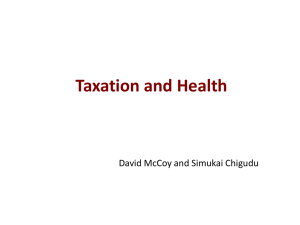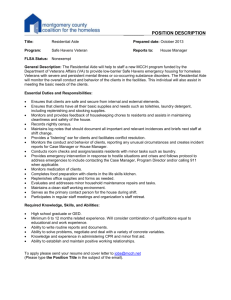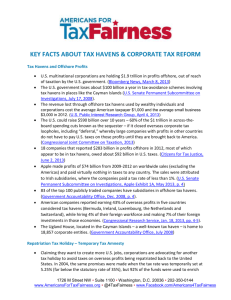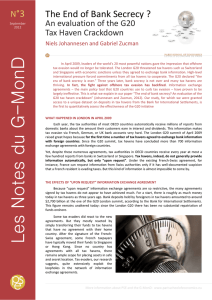Tax Havens The Facts
advertisement
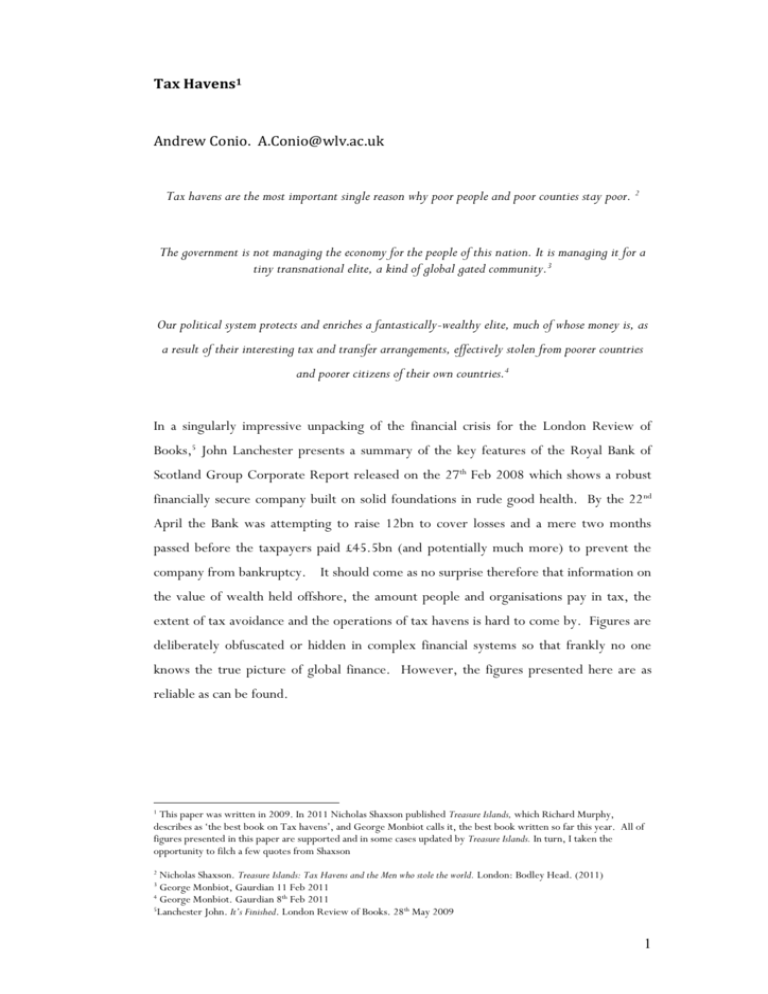
Tax Havens1 Andrew Conio. A.Conio@wlv.ac.uk Tax havens are the most important single reason why poor people and poor counties stay poor. 2 The government is not managing the economy for the people of this nation. It is managing it for a tiny transnational elite, a kind of global gated community.3 Our political system protects and enriches a fantastically-wealthy elite, much of whose money is, as a result of their interesting tax and transfer arrangements, effectively stolen from poorer countries and poorer citizens of their own countries.4 In a singularly impressive unpacking of the financial crisis for the London Review of Books,5 John Lanchester presents a summary of the key features of the Royal Bank of Scotland Group Corporate Report released on the 27th Feb 2008 which shows a robust financially secure company built on solid foundations in rude good health. By the 22 nd April the Bank was attempting to raise 12bn to cover losses and a mere two months passed before the taxpayers paid £45.5bn (and potentially much more) to prevent the company from bankruptcy. It should come as no surprise therefore that information on the value of wealth held offshore, the amount people and organisations pay in tax, the extent of tax avoidance and the operations of tax havens is hard to come by. Figures are deliberately obfuscated or hidden in complex financial systems so that frankly no one knows the true picture of global finance. However, the figures presented here are as reliable as can be found. 1 This paper was written in 2009. In 2011 Nicholas Shaxson published Treasure Islands, which Richard Murphy, describes as ‘the best book on Tax havens’, and George Monbiot calls it, the best book written so far this year. All of figures presented in this paper are supported and in some cases updated by Treasure Islands. In turn, I taken the opportunity to filch a few quotes from Shaxson 2 Nicholas Shaxson. Treasure Islands: Tax Havens and the Men who stole the world. London: Bodley Head. (2011) George Monbiot, Gaurdian 11 Feb 2011 4 George Monbiot. Gaurdian 8th Feb 2011 5 Lanchester John. It’s Finished. London Review of Books. 28th May 2009 3 1 The 11th annual World Wealth Report (2007) from Merrill Lynch/Capgemini6 finds the number of High Net Worth Individuals (HNWI) has grown to 9.5 million with their assets rising to US$37.2 trillion. That is, 0.015% of the world’s population have an asset worth of more than half of the world’s GDP, which in 2007, according to the World Bank, was US$54tn7. A third of HNWI’s assets are held in offshore accounts or tax havens (this fits with Oxfam’s findings that 1/3 of global GDP is sequestered into tax havens)8 which would give a figure of US$12.4tn. This fits almost exactly The Tax Justice Network9 estimation (2005) that placements by high net-worth individuals in tax havens totaled US$11-12tn in 2004 and both figures accurately reflect the very steep rise in the use of tax havens in the last few years leading the writers of the single most authoritative report yet written about tax havens10 to state ‘official statistics suggest that the scale of such placements increased sharply in subsequent years’. However, this world is one of dissemblance and deliberate concealment by the major financial institutions. For example, the I.M.F. does collect data in Government Financial Statistics but will not release it to either researchers or financial analysts. Or, when the British Government talks of closing tax havens as if they were semi-legal shadowy operations outside the mainstream it fails to mention that ten of the OECD’s list of 35 tax havens are UK overseas territories or dependencies of the British Crown11. No mention is made of the fact that the accounts in tax havens are often run by major financial centers, (London, New York) and according to the IMF ‘50% of international positions in the world’s banks are held in Offshore Financial Centre’s12. It will come as no surprise, then, when Obama and Brown’s huffing and bluffing about tax havens come to nothing in a few months time, because their economies are structurally dependent upon them. Returning to HNWI’s, if we estimate 1/3 of their assets are held in tax havens that would total US$12.4tn. Given the norm 7.5%13 growth p.a. this would yield US$930bn annual return. (Although the American Bureau of Economic Analysis puts the rate of return from tax 6 Capgemini (Euronext: CAP) is a major French company, one of the world's largest information technology, transformation and management consulting, outsourcing and professional services companies with a staff of over 91,000 operating in 36 countries. 7 http://web.worldbank.org/WBSITE/EXTERNAL/DATASTATISTICS/0,,contentMDK:20535285~menuPK:1192 694~pagePK:64133150~piPK:64133175~theSitePK:239419,00.html 8 Tax Havens: Releasing the hidden billions for poverty eradication. SERIES: Oxfam Briefing Papers 2000 9 Tax Justice Network is an international campaign group with headquarters in London that promotes transparency in international finance and opposes secrecy. It appears to the most respected and authrotive organization devoted solely to the investigation of Tax Havens. According to the Norwegian Royal commission into Tax Havens their findings and assumptions appear reliable 10 Tax havens and development Status, analyses and measures. Report from the Government Commission on Capital Flight from Poor Countries. Appointed by Royal Decree of 27 June 2008. Submitted to Erik Solheim, Minister of the Environment and International Development, on 18 June 2009. 11 Nick Mathiason. The Observer, Sunday 29th March 2009. 12 IMF (2000): Offshore Financial Centres – IMF Background Paper 13 Figure provided by McKinsey consulting and Boston consulting Group 2 havens at 12%).14 As 30-35% tax is the prevailing rate in most OED countries this would yield US$279bn. Actual tax paid by HNWI is 7.5% 15 or US$69.75bn. In sum, HNW individuals pocket US$209.25bn per annum in unpaid taxes although the highly respected Tax Justice Network put this figure at US$255bn in 2005. To put this in perspective $16bn a year would be sufficient to give every child in the world a school place16. The sole purpose of Tax Havens is to conceal activities from juridical and public scrutiny17 to allow for the avoidance of tax and thus creating a shortfall that has to be born either by other taxpayers, exchequers or the social infrastructure (roads, schools, hospitals). They are to all meaningful sense simply vehicles for deception.18 Profits are shipped overseas so that little or no tax is paid by a spurious company that produces nothing, employs no one and creates nothing of value. In Tax Havens no accounts are required, few standards for fit and proper governance and regulation are imposed. For example in the British Virgin Islands one single office is the registered address for 18,000 companies. The British Virgin Islands has an inward investment ratio of 2.7bn per capita. Not only do unpaid taxes seriously limit the capacity of any country to invest in the vital services, education, health systems and infrastructure needed to sustain the heath and well being of that country, they also distort the economy by diverting capital from investments which have other social values as practitioners spend more time creating new systems for tax avoidance rather than wealth creation.19 Not least amongst these effects is the distortion of national priorities and a weakening of the capacity of a nation to manage its own affairs20 and to bring to justice or public accountability 14 The Commission's calculations based on U.S. Direct Investment Abroad: Balance of Payments and Direct Investment Position Data, The Bureau of Economic Analysis (BEA) 15 Average CapGemini portfolio 16 Sebastien Fourmy, Policy and Advocacy Director from Oxfam France. 17 The great majority of the reports on suspicious transactions are shelved without investigation. Only a modest proportion lead to charges and a court judgement. Many of the tax havens have extremely large international activities relative to the size of their population and economy. In a number of cases, it is virtually inconceivable that these jurisdictions have the capacity to control money laundering, and not least to pursue cases through investigation and trial. Tax havens and development Status, analyses and measures 18 The UK tax authorities gained access in 2006 to a list of depositors with the tax-haven branches of a major bank. Of the almost 10 000 British depositors, only 3.5 per cent had provided account information to the tax authorities (confer Sullivan, Martin A. (2007): Keeping Score on Offshore: UK 60 000, US 1 300, Tax Notes, 7 July 2007). 19 Potentially the most serious consequences of tax havens are that they can contribute to weakening the quality of institutions and the political system in developing countries. Tax Havens and development. Norwegian Ministry of Foreign Affairs. 20 Take South African mining company AGA’s agreement with Tanzania. Of US$1.43bl worth of gold extracted from 200 to 2006, it paid US$96m in taxes and royalties to the Tanzanian government. Death and taxes pg 12. 3 practices that lie outside of the countries jurisdiction21. The global financial system therefore makes a major contribution to the continued existence of nation states that are essentially incompetent or perpetuate grotesque distortions of national priorities. We are not done there, a new analysis for Oxfam (March 2009)22 by James Henry, former Chief economist at McKinsey & Co, found that at least $6.2 trillion of developing country’s own wealth is held offshore, depriving developing countries of annual tax receipts of between $64-$124bn p.a. even though, according to the Tax Justice Network, this figure is an underestimation: ‘If money moved offshore by private companies was included this figure would be much higher’. Even that estimate tells only part of the story: with tax havens now involved in an estimated half of all global trade, the sums passing through will be even greater.23 This figure is far in excess of the £28-42bn the World Bank estimates will be required annually to meet the Millennium Development Goals (MDGs) aimed at halving extreme poverty by 2015. Or, according to Christian Aid, ample funds to save the lives of 350,000 children under five a year.24 In fact, these examples are only part of a far larger system of expropriation of labour value and wealth and the shift of capital from the poor to the rich. According to Christian Aid a full 50 per cent of world trade takes place through tax havens.25 Indeed, globalisation is far from a simple vehicle for exchange and trade, as 60% of world trade takes place within rather than between multinational corporations. (Not surprising when we note that 200 corporations account for more than a quarter of the world’s economic activity).26 An analysis loosely supported by Nicholas Shaxson; ‘about two thirds of Global cross border world trade happens inside multinational corporations’.27 A full 50% 21 Suharto’s embezelment of UD$15bn from Indonesia is only the largest of this type; none of which have been recovered. 22 Tagged: Tax Havens. http://www.oxfam.org/en/pressroom/pressrelease/2009-03-13/tax-haven-could-deliver120bn-year-fight-poverty. Accessed 28/07/2010 23 Closing the Floodgates, Tax Justice Network, 2007, www.globalpolicy.org/nations/launder/ haven/2007/2007taxjustice.pdf 24 Death and Taxes: the True Toll of Tax Dodging, (Andrew Hog et al) Christian Aid, 2008. 25 Death and Taxes: the True Toll of Tax Dodging, (Andrew Hog et al) Christian Aid, 2008. 26 Prem Sikka, Prof Of Accounting At University Of Essex. ‘Enterprise, culture and accountancy firms; new masters of the universe’, Accounting, Auditing and Accountability Journal, vol 21, no 2, 2008, p 268-295, 27 Nicholas Shaxson. Treasure Islands: Tax Havens and the Men who stole the world. London: Bodley Head. (2011) pg 12 4 of these intra-company trades are devices such as transfer pricing, mispricing or false invoicing which are used to transfer profits to low-tax jurisdictions to maximize tax avoidance. For example, Adobe Corporation had a turnover of US$2.6bn last year but paid a paltry US$5m in corporation tax.28 The Norwegian Royal Commission report states ‘estimates suggest the tax loss could be on the order of 30 percent of the potential revenue from foreign multinational enterprises’. Given the amount of world GDP transacted ‘intragroup’ by multinationals this would indeed be a colossal Similar to the 7% of entire Global GDP Raymond Baker, Senior Fellow of the US Center for International Policy, estimates is accounted for by mispricing and false invoicing. Indeed, these processes are part of, but do not fully account for the monumental flow of capital out of developed countries over the last few years. For reasons that have become obvious, the scale of illicit money flows from developing countries to tax havens cannot be determined precisely, but it unquestionably far exceeds development assistance or direct legitimate investment in these countries. Thus, whilst the total registered capital flows into developing countries in 2006 are estimated at US$571 billion (World Bank (2007). Donor aid accounted for US$70 billion of this figure. The most qualified estimate (Kar & Mamadov (2008)) for illegal money flows from developing countries indicates that illegal capital flows totaled US$641-979 billion. Even the lowest estimate suggests that the illegal capital outflow exceeds the net legal inflow, and the illegal outflow corresponds roughly to ten times the development assistance given to developing countries. Ndikumana and Boyce29 have calculated that ‘accumulated over the 1970-2004 period, capital flight is estimated at US$420 billion (converted to 2004 prices). With calculated interest accumulation, capital flight is assumed to total US$600 billion over the period. This corresponds to almost three times the total foreign debt of the countries concerned.’30 In many countries, particularly in sub-Saharan Africa and Latin America, capital flight is accompanied by increased foreign borrowing. This borrowing is not used to finance investment or consumption, but to finance the capital flight itself (Rodríguez 1987, Boyce & Ndikumana 2005). The ensuing debt burden will hurt the poor most, since 28 This is by no means an isolated example. In 2006 the worlds biggest banana companies Del Monte, Dole and Chiquita, did nearly $750 Million worth of business in Britain but paid £235,00 in tax. (Shaxson pg 12). 1/3 of Britains top 700 companies paid zero tax in 2007 29 James K. Boyce and Léonce Ndikumana Department of Economics and Political Economy Research Institute, University of Massachusetts Amherst, MA 01003 30 Ndikumana and Boyce – estimate of capital flight from Africa 5 public spending on the social sectors and on investment in infrastructure must be cut to service the debt. Taking into account all these factors; tax evasion by HNWI, developing countries’ own use of tax havens, capital flight and mis- and transfer-pricing and the combined effects of distortion of rational governance, we find a global financial system, which is coincidental with globalization, that is systematically, structurally and constitutionally geared towards the extraction of the wealth from the poorest, and the sequestration of the labour value and resources of such magnitude that it actually dwarfs the exploitation of the slave trade. Here is George Monbiot; Wealth is being transferred from the poor and middle to the rich at stupefying speed and on a stupefying scale. The financial sector seeks to wring every drop from the productive economy, heedless of the eventual impacts. The government is there to help.31 As Raymond Baker says: ‘for the first time in the 200-year run of the free-market system, we have built and expanded an entire integrated global financial structure the basic purpose of which is to shift money from the poor to the rich’. Indeed, between 2005 and 2007, the total amount of capital flow from bilateral trade mispricing into the EU and the US alone from non-EU countries is estimated conservatively at US$1tn. Of which Christian Aid says; The situation is stark and urgent. We predict that illegal, trade-related tax evasion alone will be responsible for some 5.6 million deaths of young children in the developing world between 2000 and 2015. That is almost 1,000 a day. Half are already dead. It is hard to imagine a more estimable advisory board (which includes the Chairperson of the European Parliament’s Committee on Development and the Managing Director of the World Bank) gathered to produce unimpeachable reports into the global financial system than that recruited by the non-profit organisation Global Financial Integrity32 who 31 Guardian 15th February 2011 Their advisory board includes Lord Daniel Brennan QC.. Francis Fukuyama. Ms Ngozi Okonjo-Iweala is the Managing Director of the World Bank. She is the former Finance Minister and Foreign Minister of Nigeria. Thomas Pogge is a professor of Philosophy and International Affairs at Yale University.."John G. Heimann is Chairman of the Financial Stability Institute of the Council on Foreign Relations. Kenneth M. Jensen is on the Executive Committee of 32 6 say of decolonization and the spread of multinational corporations – ‘the 1960s marked the point at which the expansion of the illicit financial structure took off in earnest’. 33 Their Chair Raymond Baker concludes; Economic deprivation brutalizes billions of people. This makes it necessary for us to be brutally honest with ourselves. This reality has been going on for decades and cumulatively has moved trillions of dollars out of poor countries into rich countries. This reality … propelled by the illicit financial structure that we created in good part of (sic) accomplish exactly this end, is, in my reading of history and in my judgment, the ugliest chapter in global economic affairs since slavery. The poor deserve better from us. 34 the American Committees on Foreign Relations. Eva Joly is a member of the European Parliament, and the Chairperson of the European Parliament’s Committee on Development (DEVE). David S. Landes is a professor emeritus of Economics at Harvard University. James S. McDonald is President and CEO of Rockefeller & Co. Moisés Naím is the Editor in chief of Foreign Policy magazine. In the late 1980s and early 1990s, Mr. Naím served as Venezuela’s Minister of Trade and Industry. John C. Whitehead is the former Chairman of both Goldman, Sachs & Co and the Board of the Federal Reserve Bank of New York. Mr. Whitehead served as the Deputy Secretary of State under President Reagan. 33 ‘Illicit Financial Flows and their Impact on Development’ Global Financial Integrity 34 Raymond W Baker, ‘The ugliest chapter in global economic affairs since slavery’, speech to Global Financial Integrity Program, 28 June 2007. 7
